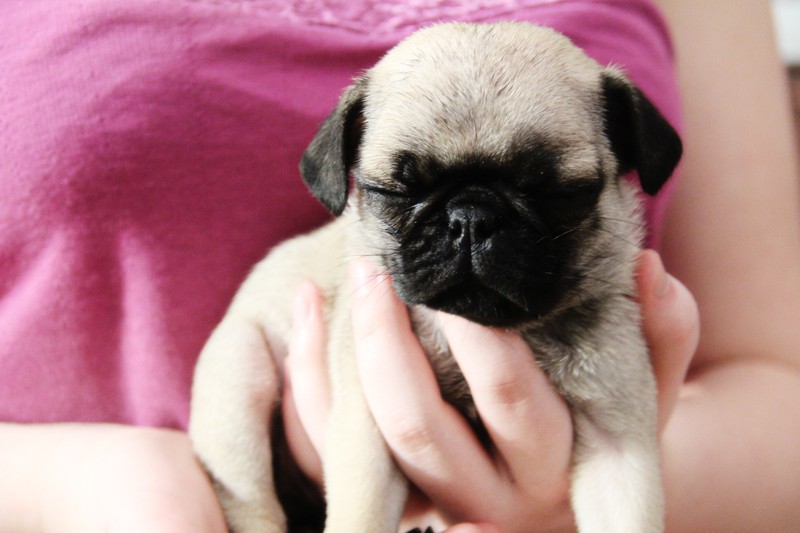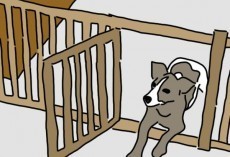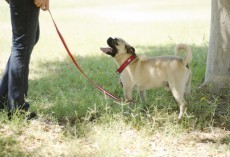Do you have the supplies needed for your new Pug puppy? Make sure you have puppy bowls, food, leashes, harnesses, treats, and more. Before you bring your pooch home, it's important to double check and make sure you have everything you need.
How to Pick a Pug Puppy for a Pet
Pugs can live 12-15 years, so you'll want to choose carefully before making a commitment to your new family member.
Here are some general guidelines you can use:
• Check out Pugs from a reputable rescue organization or visit a breeder referred by the Pug Dog Club of America.
• Ask to see the puppy’s parents or at least the mother and other relatives.
• Look at the conditions the puppy is being raised in.
• Check the puppy’s eyes. They should be bright and shining and clear of any discharges.
• Watch how the puppy moves. (S)he should walk or run without limping.
Supplies You'll Need to Welcome Your New Pet Pug
Prepare your Pug’s homecoming by having the right supplies on hand. A wire pet carrier for your Pug to ride safely in the car or to sleep inside the house.• Bedding for the carrier to make it comfy.
• Collar and leashes to take your Pug on outings.
• Identification to make sure that your Pug is returned to you if he ever gets separated from you.
• Two stainless steel bowls.
• Toothbrush and toothpaste to maintain good Pug dental health.
• Shampoo and conditioner to keep your Pug clean and smelling fresh.
• Premium food recommended by your breeder.
• Toys, toys, and more toys to keep your Pug happy and having fun.
When to Get Urgent Care for Your Pug
• Cardiac arrest: If your Pug is unconscious, stops breathing, has dilated pupils or white gums, or if you can’t detect a heartbeat, your Pug may be in cardiac arrest.
• Coma: If your dog has irregular breathing but doesn’t respond and won’t get up, he may be in a coma.
• Drowning: If your Pug stops breathing, tip your Pug’s head down and thump the chest a few times to drain the water from the airways.
• Overheating: Your Pug may collapse or have severe muscle cramps, vomiting, seizure-like tremors, or rapid breathing.
• Poisoning: Signs of poisoning can include vomiting, bloody diarrhea, tremors, excessive salivation, and nosebleeds.
How to House Train Your Pug
House-training a Pug takes time and patience.In the morning, follow these steps:
1. First thing, take your Pug outside and stay there several minutes.
2. Give him breakfast.
3. Take your Pug back outside for potty again.
4. If you can’t watch him, put him into his carrier.
5. Take your Pug outdoors every 20 minutes if you’re home.In the afternoon, here’s what to do:
1. Feed Puggy lunch.
2. Take him outside.
3. Bring him back indoors and return him to his carrier if you’re busy and can’t watch him.
If you do discover that you don't have everything you need you can always visit a pet store to get more supplies. Also, if your puppy experiences health problems when you bring him home check over the extensive list of health problems of your pooch may be experiencing on For Dummies.
Even though the list above mentions a lot of health concerns that may require urgent care, there's always more to learn. A comprehensive list of ailments, how to potty train your pooch and get him acclimated to his new home is essential. In time he'll be used to his home, fully potty trained and loving his puppy life even more!











Ingrid Ferreira
- Edit
Little Sweetheart ❤
Stephaniemae dela Cruz
- Edit
my mind is exploded by some cute pugs
Debbie Palmer
- Edit
I love Pugs but this post is just common sense.
Linda Andrews
- Edit
But remember, every Pug is an individual, and not everything in this list will apply to every Pug. :^)
Terri Tylman
- Edit
He is cute
Regina Pokropski
- Edit
Precious little Pug
Linda Andrews
- Edit
My sweet Billy (Pug) was NO trouble at all! :^)
Angel Hayes
- Edit
ROFL!